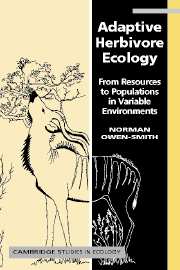Book contents
- Frontmatter
- Contents
- Acknowledgements
- Acronym and symbol conventions
- 1 Conceptual origins : variability in time and space
- 2 Consumer–resource models : theory and formulation
- 3 Resource abundance : intake response and time frames
- 4 Resource distribution : patch scales and depletion
- 5 Resource quality : nutritional gain and diet choice
- 6 Resource constraints : physiological capacities and costs
- 7 Resource allocation : growth, storage and reproduction
- 8 Resource production : regeneration and attrition
- 9 Resource competition : exploitation and density dependence
- 10 Resource-dependent mortality : nutrition, predation and demography
- 11 Habitat suitability : resource components and stocking densities
- 12 Resource partitioning : competition and coexistence
- 13 Population dynamics : resource basis for instability
- 14 An adaptive resource ecology : foundation and prospects
- References
- Index
3 - Resource abundance : intake response and time frames
Published online by Cambridge University Press: 04 February 2011
- Frontmatter
- Contents
- Acknowledgements
- Acronym and symbol conventions
- 1 Conceptual origins : variability in time and space
- 2 Consumer–resource models : theory and formulation
- 3 Resource abundance : intake response and time frames
- 4 Resource distribution : patch scales and depletion
- 5 Resource quality : nutritional gain and diet choice
- 6 Resource constraints : physiological capacities and costs
- 7 Resource allocation : growth, storage and reproduction
- 8 Resource production : regeneration and attrition
- 9 Resource competition : exploitation and density dependence
- 10 Resource-dependent mortality : nutrition, predation and demography
- 11 Habitat suitability : resource components and stocking densities
- 12 Resource partitioning : competition and coexistence
- 13 Population dynamics : resource basis for instability
- 14 An adaptive resource ecology : foundation and prospects
- References
- Index
Summary
For herbivores, food resources change in amount both intrinsically through vegetation growth and decay, and as a result of consumption. Such changes in food abundance influence the rate of food intake obtained by each individual herbivore. The relationship between food intake rate and resource abundance has conventionally been termed the ‘functional response’ (following Solomon 1949). However, because this is just one of several response functions considered in this book, I will call it specifically the intake response.
Not all of the standing vegetation biomass that a botanist would measure is effectively available for consumption by a specific herbivore. Some plant material is inaccessible, e.g. underground plant parts for most antelope and deer. Inaccessibility may be temporary; for example, leaves high in tree canopies may later be shed. A portion of plant biomass is inedible, e.g. woody trunks of trees for most ungulates. But inedibility is relative; vegetation components rejected as food at one time may later be eaten when little else is available. In effect, different plant species and parts vary over time in their acceptability to consumers. I will use the term potential food to encompass all vegetation components that are eaten at some time or other. Currently edible, accessible and acceptable material constitutes available food.
- Type
- Chapter
- Information
- Adaptive Herbivore EcologyFrom Resources to Populations in Variable Environments, pp. 38 - 60Publisher: Cambridge University PressPrint publication year: 2002



